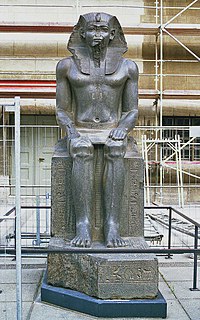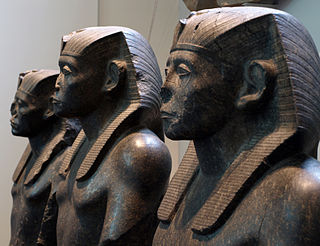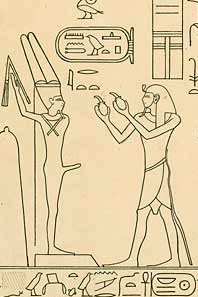
Amenemhat III, also known as Amenemhet III, was a pharaoh of ancient Egypt and the sixth king of the Twelfth Dynasty of the Middle Kingdom. He was elevated to throne as co-regent by his father Senusret III, with whom he shared the throne as the active king for twenty years. During his reign, Egypt attained its cultural and economic zenith of the Middle Kingdom.

Sobekneferu or Neferusobek was a pharaoh of ancient Egypt and the last ruler of the Twelfth Dynasty of the Middle Kingdom. She ascended to the throne following the death of Amenemhat IV, possibly her brother or husband, though their relationship is unproven. Instead, she asserted legitimacy through her father Amenemhat III. Her reign lasted 3 years, 10 months, and 24 days, according to the Turin King List.

The Twelfth Dynasty of ancient Egypt is considered to be the apex of the Middle Kingdom by Egyptologists. It often is combined with the Eleventh, Thirteenth, and Fourteenth dynasties under the group title, Middle Kingdom. Some scholars only consider the 11th and 12th dynasties to be part of the Middle Kingdom.

Sankhkare Mentuhotep III of the Eleventh Dynasty was Pharaoh of Egypt during the Middle Kingdom. He was assigned a reign of 12 years in the Turin Canon.

Amenemhat IV was the seventh and penultimate king of the Twelfth Dynasty of Egypt during the late Middle Kingdom period, ruling for more than nine years in the late nineteenth century BC or the early eighteenth century BC.

Amenemhat I, also known as Amenemhet I, was a pharaoh of ancient Egypt and the first king of the Twelfth Dynasty of the Middle Kingdom.

Nubkaure Amenemhat II, also known as Amenemhet II, was the third pharaoh of the 12th Dynasty of ancient Egypt. Although he ruled for at least 35 years, his reign is rather obscure, as well as his family relationships.

Khakaure Senusret III was a pharaoh of Egypt. He ruled from 1878 BC to 1839 BC during a time of great power and prosperity, and was the fifth king of the Twelfth Dynasty of the Middle Kingdom. He was a great pharaoh of the Twelfth Dynasty and is considered to be, perhaps, the most powerful Egyptian ruler of the dynasty. Consequently, he is regarded as one of the sources for the legend about Sesostris. His military campaigns gave rise to an era of peace and economic prosperity that reduced the power of regional rulers and led to a revival in craftwork, trade, and urban development. Senusret III was among the few Egyptian kings who were deified and honored with a cult during their own lifetime.

Nebtawyre Mentuhotep IV was the last king of the 11th Dynasty in the Middle Kingdom. He seems to fit into a 7-year period in the Turin Canon for which there is no recorded king.

The Thirteenth Dynasty of ancient Egypt is often combined with Dynasties XI, XII and XIV under the group title Middle Kingdom. Some writers separate it from these dynasties and join it to Dynasties XIV through XVII as part of the Second Intermediate Period. Dynasty XIII lasted from approximately 1803 BC until approximately 1649 BC, i.e. for 154 years.
Lisht or el-Lisht is an Egyptian village located south of Cairo. It is the site of Middle Kingdom royal and elite burials, including two pyramids built by Amenemhat I and Senusret I. The two main pyramids were surrounded by smaller pyramids of members of the royal family, and many mastaba tombs of high officials and their family members. They were constructed throughout the Twelfth and Thirteenth Dynasties. The site is also known for the tomb of Senebtisi, found undisturbed and from which a set of jewelry has been recovered. The pyramid complex of Senusret I is the best preserved from this period. The coffins in the tomb of Sesenebnef present the earliest versions of the Book of the Dead.

Hor Awibre was an Egyptian pharaoh of the 13th Dynasty reigning from c. 1777 BC until 1775 BC or for a few months, c. 1760 BC or c. 1732 BC, during the Second Intermediate Period. Hor is known primarily thanks to his nearly intact tomb discovered in 1894 and the rare life-size wooden statue of the king's Ka it housed.

Sekhemre Khutawy Sobekhotep was an Egyptian pharaoh of the 13th Dynasty during the Second Intermediate Period, who reigned for at least three years c. 1800 BC. His chronological position is much debated, Sekhemre Khutawy Sobekhotep being either the founder of the dynasty, in which case he is called Sobekhotep I, or its twentieth ruler, in which case he is called Sobekhotep II. In his 1997 study of the Second Intermediate Period, the Egyptologist Kim Ryholt makes a strong case for Sekhemre Khutawy Sobekhotep as the founder of the dynasty, a hypothesis that is now dominant in Egyptology.

Ameny Qemau was an Egyptian pharaoh of the 13th Dynasty during the Second Intermediate Period. According to Egyptologists Kim Ryholt and Darrell Baker, he was the 5th king of the dynasty, reigning for 2 years over most of Egypt, except perhaps the eastern Nile Delta, from 1793 BC until 1791 BC.

The pyramid of Amenemhat I is an Egyptian burial structure built at Lisht by the founder of the Twelfth Dynasty of Egypt, Amenemhat I.

Senebsumai was an ancient Egyptian official of the early 13th Dynasty with the title high steward and later treasurer.
The Treasurer in Ancient Egypt is the modern translation of the title imi-r ḫtmt. The office is known since the end of the Old Kingdom, where people with this title appear sporadically in the organization of private estates.
Nubhetepti-khered was an ancient Egyptian king's daughter of the Thirteenth Dynasty. She is basically only known from her undisturbed burial at Dahshur which was discovered in 1894 by Jacques de Morgan, close to the pyramid of Amenemhat III.

Seankhibre Ameny Antef Amenemhat VI was an Egyptian pharaoh of the early Thirteenth Dynasty ruling in the first half of the 18th century BC during a time referred to as the late Middle Kingdom or early Second Intermediate Period, depending on the scholar. Amenemhat VI certainly enjoyed a short reign, estimated at 3 years or shorter. He is attested by a few contemporary artefacts and is listed on two different king lists. He may belong to a larger family of pharaohs including Amenemhat V, Ameny Qemau, Hotepibre Qemau Siharnedjheritef and Iufni.

Khenmet was an ancient Egyptian king's daughter of the Twelfth Dynasty, around 1800 BC. She is mainly known from her unrobbed tomb containing a set of outstanding personal adornments.

















